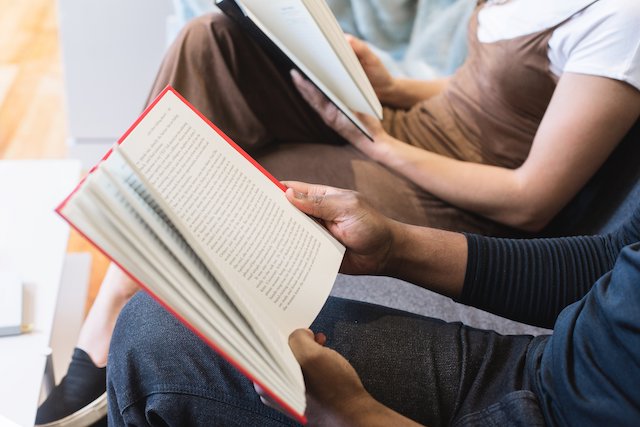How to Read More in Less Time and Comprehend More

The one piece of advice that is common when coming from successful people is to read more. They dedicate their knowledge about their specific fields to reading.
“Once you learn to read, you will be forever free.”
– Frederick Douglas
If you want to learn about anything, read.
If you want to grow, read.
If you want to polish your skills, read.
If you want to sharpen your mind, read.
Reading isn’t limited to only books. With the internet comes a ton of reading material to choose from. You don’t even have to go out to get a newspaper or magazine; everything is online. Why not make the most of it. Reading – books, newspapers, magazines, poems, stories, blogs, articles – anything counts.
With so much to read, one question that I usually come across is how to find time to read. Now, this is one of the questions that you can answer the best because you know your schedule better than anyone else. Like everything else you do, you need to find time to read.
How to find time for reading

“If you are going to get anywhere in life you have to read a lot of books.”
– Roald Dahl
Look at your schedule, find the time that you spend watching TV, shows, YouTube videos, Netflix. Reserve half of that time for reading. Calculate the time it takes to commute (if you use public transport) and reserve it for reading. Find the days you have appointments that have a little waiting time, take a book along.
The point here is to read in the little time gaps you get. If you can’t find out a few hours space to dedicate to reading, sprinkle it in between your commitments.
Better yet, you have to make reading your priority, you need to find time for it. If you really want to do something, saying you don’t have time means you don’t really want to do it. Because when you really want to, you find the time.
Why should you base reading goals on your reading speed?

If you want to set a routine then being realistic about it is the best way to go. Just because Warren Buffett reads 500 pages a day, doesn’t mean you have to. Take inspiration from things and tweak it according to your situation, following others down to the T can actually ruin the whole thing for you.
Find out how many pages you can read on an average, or how many words per minute. Staples (the popular office supply chain) has a test you can take to find out how fast you read. They collected reading speed data as part of their advertising campaign for selling e-readers. The speed reading tool used for the campaign is available online to try.
Use the speed reading tool, take the test, and see how fast you can read.
The test also asks questions based on the passage you read to see if you actually comprehend what you read. Just reading fast means nothing if you can’t actually retain the information.
According to the data on how fast other demographics read against yours, which can be seen after you answer the question, the average adult reads 300 words per minute.
Here are the demographics shown on the Staples graph-
- Third-grade students – 150 words per minute
- Eight grade students – 250 words per minute
- Average college student – 450 words per minute
- Average “high-level executives” – 575 words per minute
- Average college professor – 675 words per minute
- Speed readers – 1,500 words per minute
- World speed reading champion – 4,700 words per minute
If you are not a regular reader, chances are you will fall between eight grade students and average college student, that is, 250 to 450. People who never read, easily fall under the eight grade students mark.
This isn’t to judge your reading speed as slow or anything. You just need to know this so that you can make a realistic timetable for your reading.
What kind of reading is best for you?

“Reading is a basic tool in the living of a good life.”
– Mortimer J. Adler
There are four types of reading that are used by most of us.
1. Scanning – Scanning means looking for only specific information while reading, like using keywords.
Examples of this are: searching for a name in a phonebook, searching for your favorite soup on the menu.
2. Skimming – Skimming is the opposite of scanning, here you gather the main idea of the text, then you look for information or lines to back up the general idea of the text. This is used to read more in less time.
Examples of this are: reading other people’s reviews while buying products, reviewing your notes before an examination.
3. Intensive Reading – This is one of the most time-consuming reading techniques because it is used to retain information for the long term, so you read every word carefully.
Examples of this are: reading legal documents, reading business proposals, non-fiction works.
4. Extensive Reading – Extensive reading is the technique used when you read for pleasure. You choose your material, your pace, and the way you comprehend. This helps you read for fun while helping you improve your writing, better your vocabulary, and increase your comprehension power.
Examples of this are: Fiction, poetry, fun articles.
Now that you know the main kinds of reading we do depending on different material and different situations, you need to figure out what are you aiming for. If you are looking to read more, then you surely are aiming for intensive or extensive reading.
Intensive Reading works best for non-fiction because you want to actually use the information in real life, make lifestyle changes based on what you read, and apply your knowledge obtained from reading. For this, you need to remember what you read and grasp the concepts entirely.
To get the most out of a book, what you can do is make notes as you go. Use highlighters to highlight the paragraphs that you find important, use sticky notes to write your thoughts, scribble in the margins, use tons of page markers. Writing a review of the book, once you are done, also helps. When you come back to the book in the future, you will be able to recall information based on your takeaways from the book.
Extensive reading works best for fiction is because you aren’t reading to retain information. You are reading for entertainment, for fun, to just enjoy. This is one of the most popular hobbies and the reason why fiction sells.
Fiction has important lessons to teach too, but those are mostly life lessons hidden away in the story. Although this is done for fun, you actually improve your reading, writing, vocabulary, and comprehension skills, which is why you are always suggested to pick up reading as a hobby.
Why do you want to read more?

“In the case of good books, the point is not to see how many of them you can get through, but rather how many can get through to you.”
– Mortimer J. Adler
People thinking about reading more boils down to two things: reading faster, and reading lots. A combination of both is every book lover’s dream. When both are incorporated simultaneously, it can boost your reading routine to another level. Both of the things, when done alone on their own, have their benefits too.
Reading more can mean different things for different people:
- Having more time to read
- Reading faster/ Speed reading
- Reading more books
- Finishing all the books started but never finished
- And so on
Tips for reading more

“The more that you read, the more things you will know. The more that you learn, the more places you’ll go.”
– Dr. Seuss
I would suggest taking a speed reading class to pick up some things, but apart from that, here are some techniques you can use.
- Listen to audiobooks – People who have difficulty reading can start by listening to audiobooks. Listening to audiobooks means you do not have to take time out of your routine apart to do it, you can listen to it while doing other things. Many people have started realizing how beneficial it is.
You can listen to audiobooks while cleaning your home, doing laundry, cooking, commuting, taking a walk, going to the gym, etc. Even by incorporating it in your daily routine you actually get to listen to a lot more than having to take time out to read.
- Adopt a new way – If you really have no time to read, say you work two jobs and are thinking of starting your own business. You would obviously want to learn all you can. There’s where you have to think outside the box.
You can listen to reviews by people who have read a particular book you want to read and get the summary. Most of the time, people give their opinion with the review so it sort of takes away the privilege of forming your own opinion. So if that doesn’t bother you then go for it. Listen to 3-4 people whose opinions you value.
If you are really short on time, then use a service like Blinkist, which has summaries of almost all the popular non-fiction books and are adding more daily. I have a premium subscription of Blinkist and make it a point to read at least one summary each day. And this is apart from the reading I do on a daily basis. Blinkist basically helps me decide which books I want to read by reading a 15-minute summary of that book. The best part is that these summaries are available in text as well as audio format. This changes the way we consume books.
- Take up reading challenges – Reading challenges motivate everyone, if you would like accountability for your challenges, then join reading groups. Goodreads and Facebook have reading groups that support each other to reach their reading goals. There are various reading challenges that run on YouTube and Instagram that you can participate in. There are also yearly challenges you can participate in, keeping track of the books you read based on the genre, publication, author, and so on. You can find my yearly challenge on Goodreads here.

- Use a pen as a pointer – Remember how we were always told to read with our fingers pointing at the words when we were kids, it’s the same thing. This technique makes sure to keep your eyes directed at the sentence you are reading and also doesn’t let you lose your place in the paragraph.
- Buy an e-reader – An e-reader like Kindle means you don’t have to carry a bulky book any place you go. If you are not into the book you are reading, you can quickly change the book. There are tons of free books. You can get any book you want, no matter where you are. The books cost you less in terms of money as well as the time required to get a physical book. This gives you no other reason not to read. For the record, I use a Kindle Paperwhite.
- Make time to read – Saying I don’t have time just won’t do if you really want to incorporate reading into your routine. You have to give up some other hobby to fit reading in, or you just would have to find time to do both.
Reading more depends as much on your decision as it does on a mixture of all of these tips. If you decide that no matter what, you are going to find time for reading, then you have half the battle won already.
“Luckily, I always travel with a book, just in case I have to wait on line for Santa, or some such inconvenience.”
– David Levithan
Some classes you can take to learn how to speed read and comprehend what you are reading-
-
Quotes1 year ago
30 Inspirational Thoughts For The Day
-
Self Improvement1 year ago
7 Tips To Recreate Your Life In 3 Months And Change Your Destiny
-
Motivation1 year ago
5 Excellent Ways To Stay Focused On Your Dreams
-
Quotes1 year ago
21 Quotes About Chasing Perfection And Striving For It
-
Health1 year ago
4 CBD Products Your Dog Deserves To Have
-
Personal Finance2 months ago
How Do I Find My UCAS ID Number?
-
Entrepreneurs1 year ago
1Password Evaluation – The Highest Ranked Password Manager Out There
-
Entrepreneurs1 year ago
51 Lucrative Ways to Make Money From Home



























